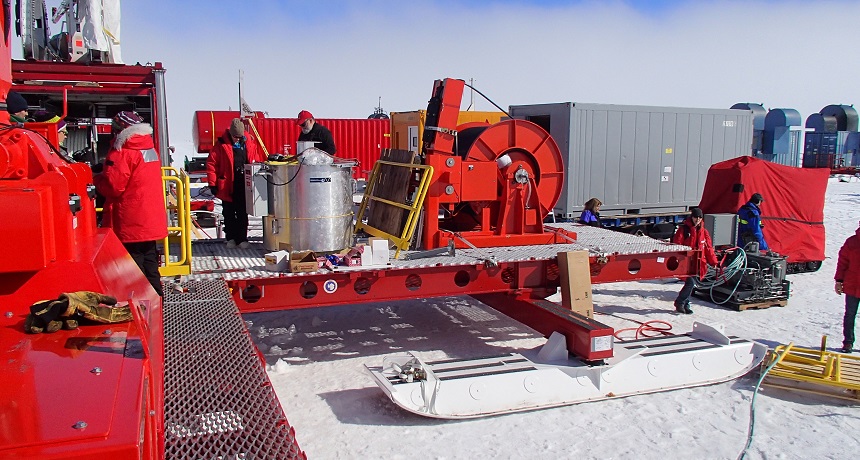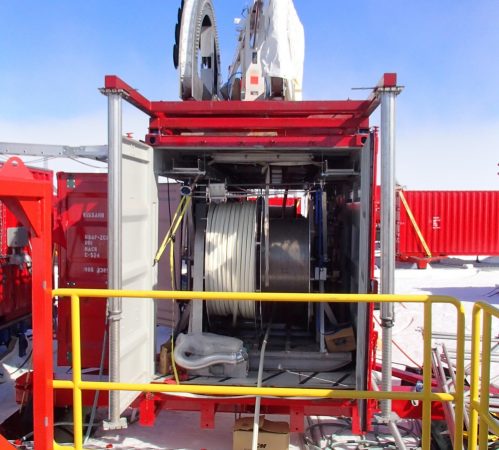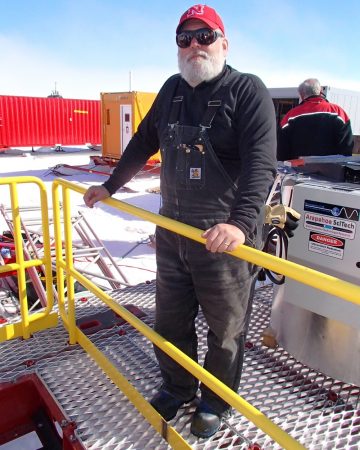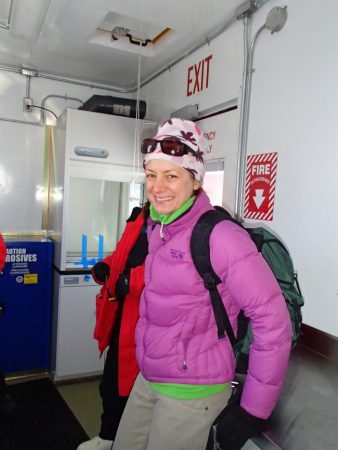Piercing a buried polar lake
Researchers in Antarctica drilled through a half-mile of ice to reach water that hasn’t had contact with the atmosphere for thousands of years.

Here is some of the heavy drill equipment and other machinery hauled to Antarctica from the United States. This gear was specially designed for an experiment to drill nearly a half-mile through the ice and into Lake Whillans. The purpose: to hunt for life.
J. Raloff/Science News
By Janet Raloff
This is the first in a series of stories that are based in part on reporting in Antarctica by the editor of Science News for Kids. Support for the Antarctica project was provided by the National Science Foundation and contributions to a Kickstarter fundraising initiative.
Note: This story was updated on Feb. 1, 2013
Three research teams from around the world have been drilling deep into the ice that covers Antarctica in search of liquid water. It’s not because they’re thirsty. These scientists have been hoping instead to find what types of life may be able to survive extreme conditions. Any aquatic life in a buried lake would exist in the cold and dark — and without access to Earth’s atmosphere for at least thousands (and maybe millions) of years. On January 28, the American team became the first to reach one of those buried lakes and to retrieve very clean samples of its water for testing.
And the bonanza: They found living cells in this Lake Whillans.
They don’t yet know what type of cells. They might be bacteria, Archaea or other types of microbes. Finding out which ones will take analyzing the DNA fingerprint of each type of germ. That’s not something that the scientists can do from their tent city on the ice, explains Brent Christner. He’s a scientist at Louisiana State University in Baton Rouge. Science News for Kids reached him by satellite phone from his tent encampment at the drill site on January 31. There his group has been analyzing the Lake Whillans cells.

The U.S. team used sterile equipment to break into and sample water from Lake Whillans. It wasn’t easy to keep everything clean every step of the way. “But it’s absolutely critical,” Siegert says. All tools lowered into the lake and samples taken out must be kept really clean. Only hat way, he says, “can we be confident about the quality of the data.” For instance, it ensures that any living cells that turn up are actually coming from the lake — and are not simply contaminants from somewhere else.

The forbidding Lake Whillans site is fewer than 643 kilometers (400 miles) from the South Pole. There, engineers set up a new type of hot-water drill to bore through 800 meters (a half mile) of ice. The drill was designed over the past year at the University of Nebraska, Lincoln, and tested for the first time in December. It had to be rugged, notes designer Frank Rack. Although January is summer at the drill site, with 24 hours of sunlight, the working conditions are frigid. The entire surface of the site is permanently jacketed in ice.
Rack’s team finished assembling its drill over Lake Whillans on January 21. After two days of testing, they got it shooting a high-pressure stream of 90° Celsius (194° Fahrenheit) water into the ice. The source of this stream: melted snow. Eventually, the drill cut a 30-centimeter hole (nearly a foot across) down to the top of Lake Whillans. For a few short days, the scientists were able to send a video camera and other instruments down the hole. Some tools measured the lake’s temperature and depth. Others brought back 10-liter samples of water. Still others retrieved filters placed to sift microscopic particles — and any living organisms — from the water.
Reaching the lake required removing lots of ice — about 227 metric tons (a half-million pounds) — from the borehole. The new drill had to be up to the task. That’s why the researchers rehearsed one month earlier. That test run was on a deep shelf of ice. It was floating, although still firmly attached to the coast of Antarctica. There, the drill had to pierce only 85 meters to reach seawater. On December 18, that testing went off without a hitch.
Afterward, the scientists packed up their gear and hauled it roughly 1,100 kilometers overland. This traverse took several weeks.

The Lake Whillans science team has spent more than 6 years and budgeted more than $10 million for this project. What makes it worth the money and effort? “We’re going into the unknown — one of the last frontiers — which makes it very exciting,” says John Priscu. He is a lead scientist on the project who otherwise works at Montana State University in Bozeman. His comments were reported to the Antarctic Sun. It’s an online news publication run by the U.S. National Science Foundation.

What scientists probing the buried lakes most hoped to find were signs of life. They never expected to find anything nearly as big as a fish, explains Jill Mikucki. She’s a biologist on the U.S. team who ordinarily works at the University of Tennessee in Knoxville. With no light, a primary source of energy for most organisms, Lake Whillans inhabitants would have to survive on little food. Their diet might consist of little more than minerals, such as ones released from the lake bed by erosion.
With little food and energy available, Mikucki says, her team expected that any life-forms they turned up would also be tiny. As in microscopic.
The researchers rushed the lake samples and filters that they hauled to the surface into a nearby mobile science lab. It was outfitted with lots of equipment, from microscopes and refrigerators to dishes with food that bacteria love to eat.
Biologists immediately put anything that looked like it could be an organism under the microscope. That would allow them to scout for possible viruses, bacteria or other types of germs, explains Tristy Vick-Majors. She’s a virus expert on the team from Montana State University in Bozeman.
A key test for the microbes: to see if they were using oxygen. That would be a sign that they were living.
Christner explains that snow and glacial ice contain plenty of microbes, and their dead bodies. “We are not really interested in microbial corpses, which may be just melting out of the ice and into the lake [below],” he says. So his group ran some quick tests. And those experiments indicated that the cells retrieved from the Lake Whillans were using oxygen. Concludes Christner, that indicates “they’re actually alive.”
After those first tests, the biologists carefully packed up the cells so that they could travel to the United States and Europe. There teams of scientists can probe the cells’ DNA. That should help identify whether these microbes are unusual — or similar to those found at many spots around the world.
That step will take quite a while longer, Vick-Majors says. But her team is patient. The program to survey Lake Whillans and its ecosystems is expected to last several years. Many who were out working on “the ice” this year were already planning to return again next summer.
Power Words
Antarctica The southernmost continent. It is mostly ice-covered and surrounds the geographic South Pole (from which every direction is North).
DNA Genetic material found in nearly every cell. It consists of two twisted strands of material containing instructions for how cells should function.
engineer People who apply science to solve problems or challenges, such as how to design devices, how to build structures that will stand up to stress or how to protect materials from degrading.
frontier A border between two lands; the furthermost limit of what is known, understood or has been achieved.
subglacial Existing below the ice in a glacier or below an immense layer of ice.
microscopic Something that is not visible to the naked (unaided) eye.
traverse To travel along a path. In this story, it’s the name for the overland hauling by trucks of heavy equipment. It’s used because the land is so formidable and the equipment is too heavy to fly in, or there are no airfields available.







